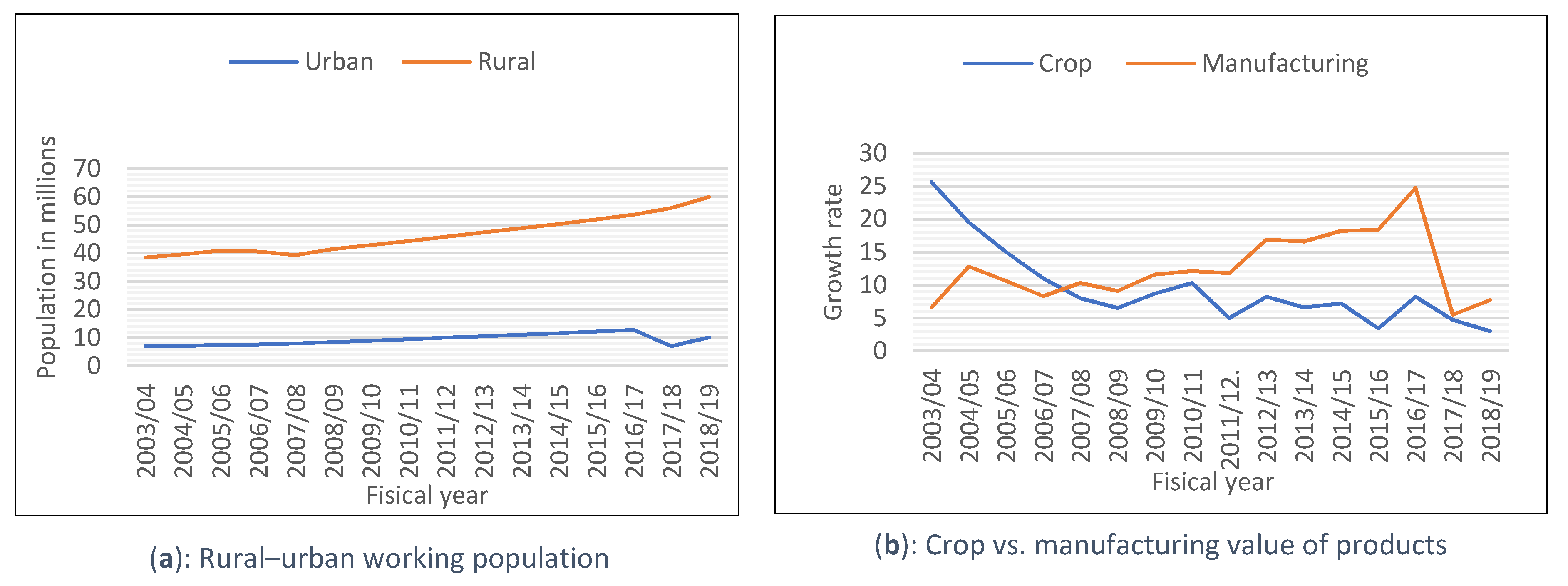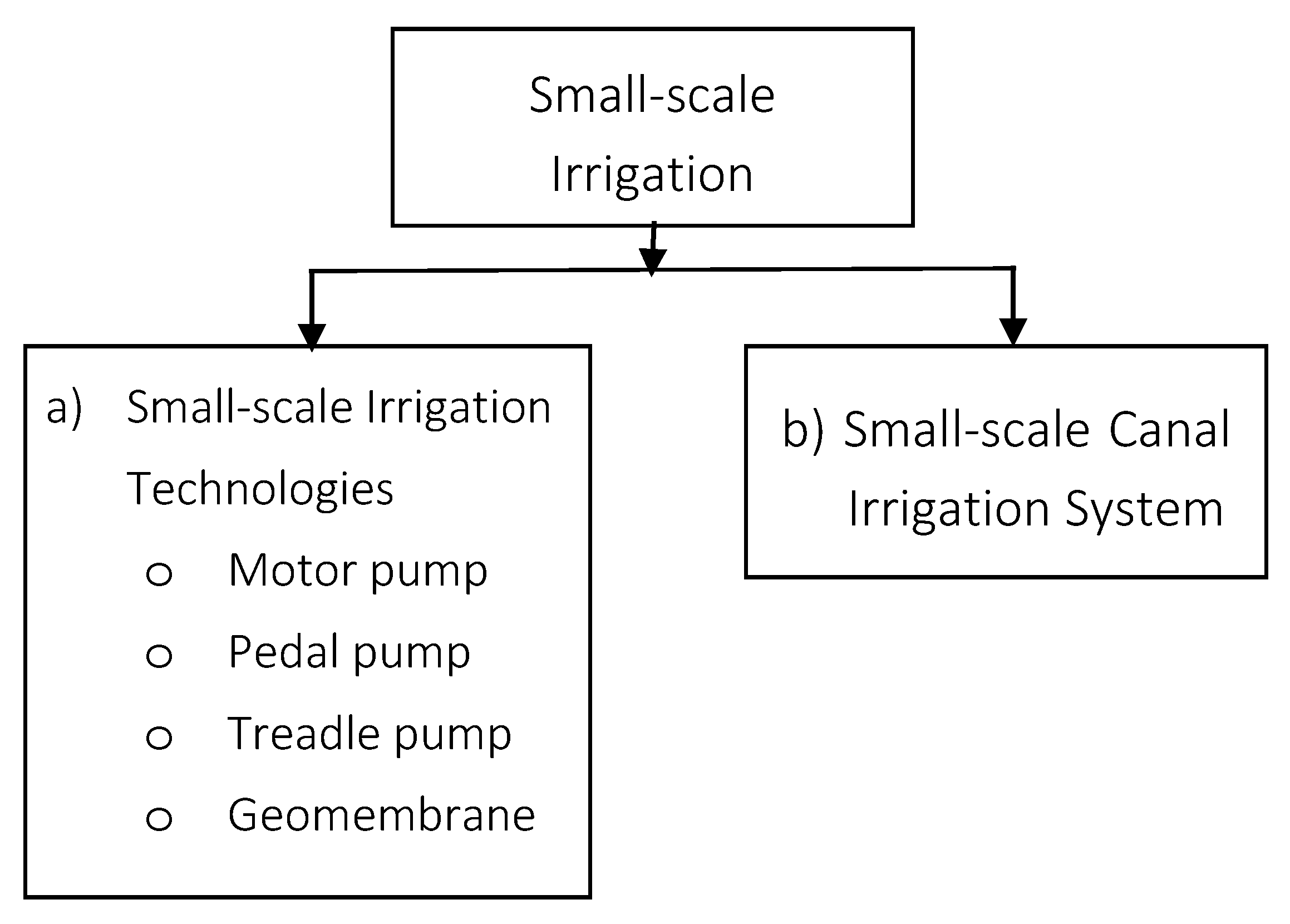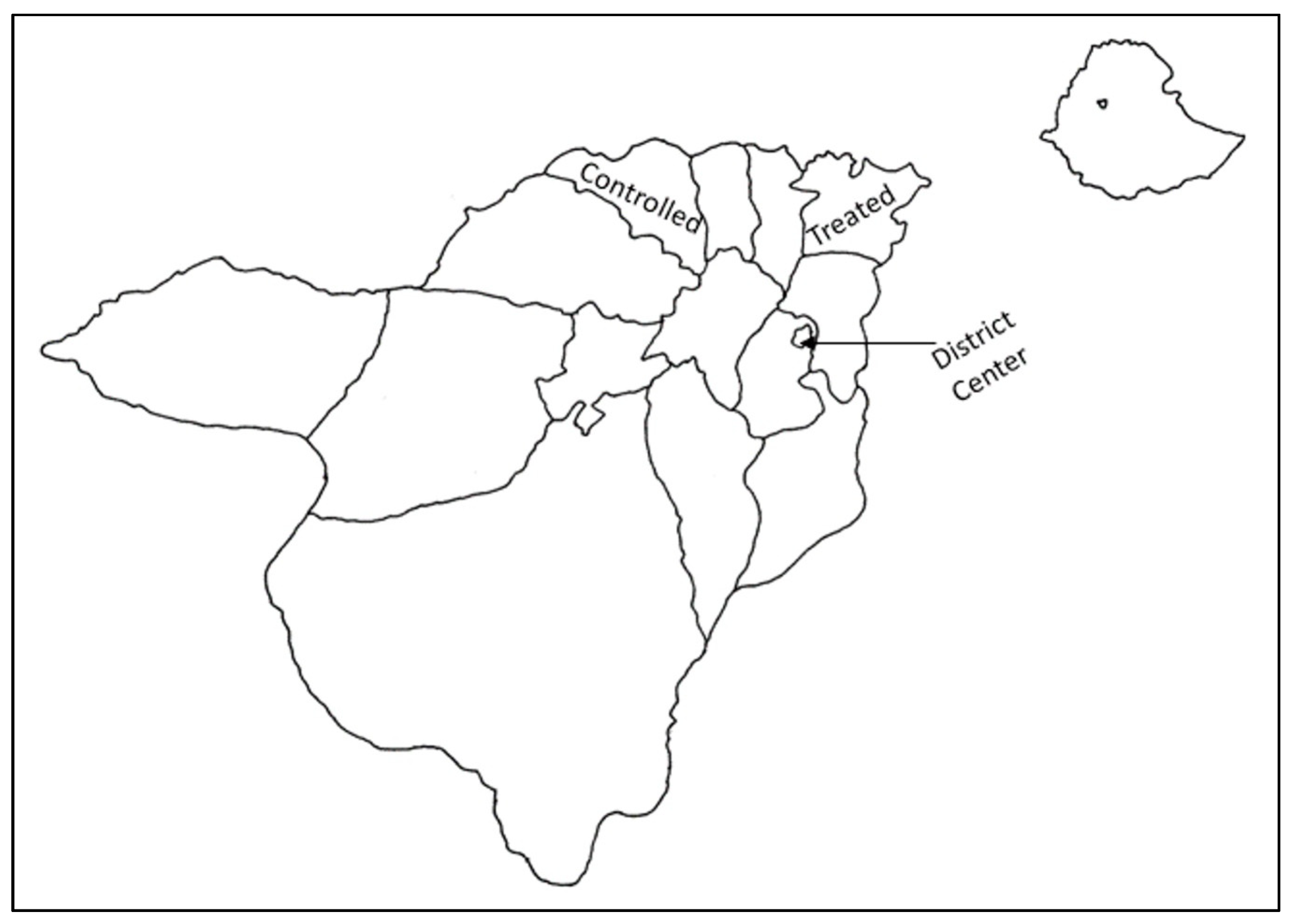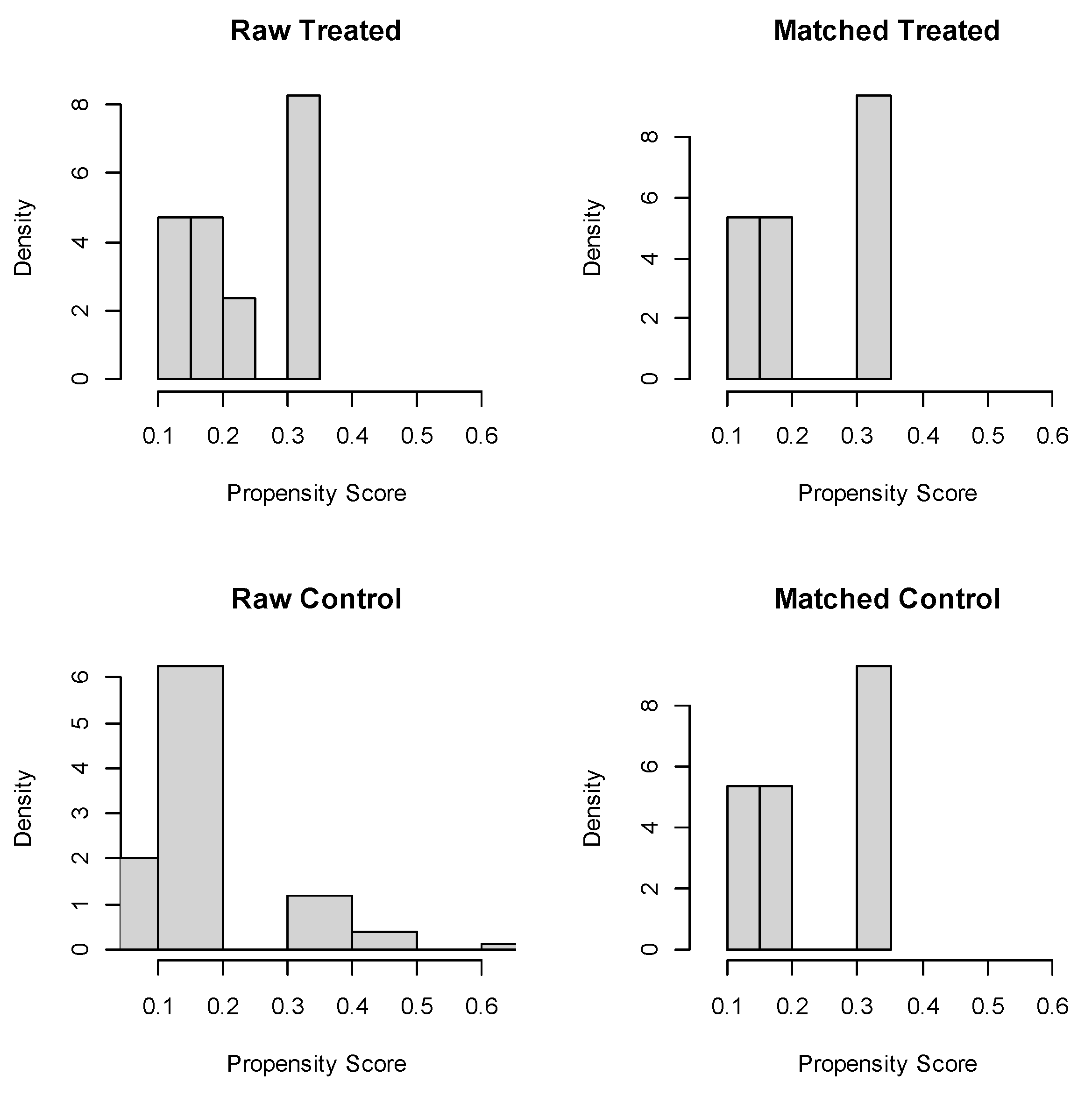The Impact of Using Small-Scale Irrigation Motor Pumps on Farmers’ Household Incomes in Ethiopia: A Quasi-Experimental Approach
Abstract
1. Introduction
2. Materials and Methods
2.1. Sampling and Data Collection
2.2. Data Analysis Method
3. Results and Discussion
3.1. Descriptive Statistics
3.2. Estimation Results
4. Conclusions
Author Contributions
Funding
Acknowledgments
Conflicts of Interest
References
- National Bank of Ethiopia (NBE). National Bank of Ethiopia Annual Report; Annual Report 2018/2019; National Bank of Ethiopia: Addis Ababa, Ethiopia, 2019. [Google Scholar]
- IMF. Real GDP Growth Annual Percent Change. Available online: https://www.imf.org/external/datamapper/NGDP_RPCH@WEO/OEMDC/ADVEC/WEOWORLD (accessed on 17 June 2020).
- Ethiopian Investment Commission (EIC). Ethiopian investment Report; Annual Report 2019; Ethiopian Investment Commission: Addis Ababa, Ethiopia, 2019.
- Planning and Development Commission (PDC). Poverty and economic growth in Ethiopia (1995/96–2015/16); Planning and Development Commission: Addis Ababa, Ethiopia, 2018.
- UNDP Ethiopia. Ethiopia’s progress towards eradicating poverty. In Implementation of the Third United Nations Decade for the Eradication of Poverty (2018–2027) Discussion Paper; UNDP Ethiopia: Addis Ababa, Ethiopia, 2018. [Google Scholar]
- World Bank. World Development Indicators; The World Bank Data Bank: Washington, DC, USA, 2016. [Google Scholar]
- Wondimagegnhu, B.A.; Bogale, B.A. Small-scale irrigation and its effect on food security of rural households in North-West Ethiopia: A comparative analysis. Ethiop. J. Sci. Technol. 2020, 13, 31–51. [Google Scholar] [CrossRef]
- Yihdego, A.G.; Adera, A.; Gelaye, M.T. The impact of small—Scale irrigation on income of rural farm households: Evidence from ahferom woreda in Tigray, Ethiopia. Int. J. Bus. Econ. Res. 2015, 4, 217. [Google Scholar] [CrossRef]
- National Planning Commission (NPC). Growth and Transformation Plan II (GTP II) (2015/16–2019/20); National Planning Commission: Addis Ababa, Ethiopia, 2016; Volume I.
- Ali, A.; Rahut, D.B.; Behera, B. Factors influencing farmers’ adoption of energy-based water pumps and impacts on crop productivity and household income in Pakistan. Renew. Sustain. Energy Rev. 2016, 54, 48–57. [Google Scholar] [CrossRef]
- Mengistie, D.; Kidane, D. Assessment of the impact of small-scale irrigation on household livelihood improvement at Gubalafto District, North Wollo, Ethiopia. Agriculture 2016, 6, 27. [Google Scholar] [CrossRef]
- Tesfaye, A.; Bogale, A.; Namara, R.E.; Bacha, D. The impact of small-scale irrigation on household food security: The case of Filtino and Godino irrigation schemes in Ethiopia. Irrig. Drain. Syst. 2008, 22, 145–158. [Google Scholar] [CrossRef]
- Berg, M.V.D.; Ruben, R. Small-Scale irrigation and income distribution in Ethiopia. J. Dev. Stud. 2006, 42, 868–880. [Google Scholar] [CrossRef]
- Ahmed, B.; Mume, J.; Kedir, A. Impact of small-scale irrigation on farm income generation and food security status: The case of lowland areas, Oromia, Ethiopia. Int. J. Econ. Empir. Res. (IJEER) 2014, 2, 412–419. [Google Scholar]
- Gebregziabher, G.; Namara, R.E. Investment in irrigation as a poverty reduction strategy: Analysis of small-scale irrigation impact on poverty in Tigray, Ethiopia. Asian J. Agric. Dev. 2017. [Google Scholar] [CrossRef]
- Adugna, E.; Ermias, A.; Mekonnen, A.; Mihret, D. The role of small scale irrigation in poverty reduction. J. Dev. Agric. Econ. 2014, 6, 12–21. [Google Scholar] [CrossRef]
- Lumley, T. Analysis of Complex Survey Samples. J. Stat. Softw. 2004, 9, 1–19. [Google Scholar] [CrossRef]
- Lumley, T. Package Survey. Version 4.0. 2020. Available online: http://faculty.washington.edu/tlumley/survey (accessed on 30 May 2020).
- Deaton, A.; Zaidi, S. Guidelines for Constructing Consumption Aggregates for Welfare Analysis; World Bank Publications: Washington, DC, USA, 2002; Available online: http://documents.worldbank.org/curated/en/206561468781153320/Guidelines-for-constructing-consumption-aggregates-for-welfare-analysis (accessed on 29 July 2020).
- Anguko, A. Livelihoods in Ethiopia: Impact Evaluation of Linking Smallholder Coffee Producers to Sustainable Markets; OXFAM GB: Oxford, UK, 2015. [Google Scholar] [CrossRef]
- Diacon, P.-E.; Maha, L.-G. The Relationship between Income, Consumption and GDP: A Time Series, Cross-Country Analysis. Procedia Econ. Finance 2015, 23, 1535–1543. [Google Scholar] [CrossRef]
- Viet, Q.V. Measurement of GDP by final expenditure approach: An introduction. In Proceedings of the International Workshop on Measuring GDP by Final Demand Approach, Shenzhen, China, 25–27 April 2011; Available online: https://unstats.un.org/unsd/economic_stat/China/GDPFE/Measuring%20GDP%20by%20final%20expenditure%20approach-an%20introduction.pdf (accessed on 17 June 2020).
- Greenlaw, D.S.S.A.; Shapiro, D. Principles of Economics, 2nd ed.; Rice University, OpenStax: Houston, TX, USA, 2017. [Google Scholar]
- Khandker, S.; Koolwal, G.B.; Samad, H. Handbook on Impact Evaluation; World Bank: Washington, DC, USA, 2009. [Google Scholar]
- Caliendo, M.; Kopeinig, S. Some practical guidance for the implementation of propensity score matching. J. Econ. Surv. 2008, 22, 31–72. [Google Scholar] [CrossRef]
- Rosenbaum, P.R.; Rubin, D.B. The central role of the propensity score in observational studies for causal effects. Biometrics 1983, 70, 41–55. [Google Scholar] [CrossRef]
- Rosenbaum, P.R.; Rubin, N.B. Constructing a control group using multivariate matched sampling methods that incorporate the propensity score. Am. Stat. 1985, 39, 33. [Google Scholar] [CrossRef]
- Zeweld, W.; Van Huylenbroeck, G.; Hidgot, A.; Chandrakanth, M.G.; Speelman, S. Adoption of small-scale irrigation and its livelihood impacts in Northern Ethiopia. Irrig. Drain. 2015, 64, 655–668. [Google Scholar] [CrossRef]
- Rubin, N.B. Matching to Remove Bias in Observational Studies. Biometrics 1973, 29, 159. [Google Scholar] [CrossRef]
- Ravallion, M. Evaluating anti-poverty programs. In Measuring Aversion to Debt: An Experiment Among Student Loan Candidates; World Bank: Washington, DC, USA, 2005; Volume 4, pp. 3787–3846. [Google Scholar]
- Brookhart, M.A.; Schneeweiss, S.; Rothman, K.J.; Glynn, R.J.; Avorn, J.; Stürmer, T. Variable selection for propensity score models. Am. J. Epidemiol. 2006, 163, 1149–1156. [Google Scholar] [CrossRef]
- Dehejia, R.H.; Wahba, S. Propensity score-matching methods for nonexperimental causal studies. Rev. Econ. Stat. 2002, 84, 151–161. [Google Scholar] [CrossRef]
- Headey, D.; Dereje, M.; Taffesse, A.S. Land constraints and agricultural intensification in Ethiopia: A village-level analysis of high-potential areas. Food Policy 2014, 48, 129–141. [Google Scholar] [CrossRef]
- Rapsomanikis, G. The Economic Lives of Smallholder Farmers: An Analysis Based on Household Data from Nine Countries. Food and Agriculture Organization of the United Nations, 2015. Available online: http://www.fao.org/3/a-i5251e.pdf (accessed on 29 July 2020).
- Aseyehegu, K.; Yirga, C.; Rajan, S. Effect of Small-Scale Irrigation On The income of rural farm households: The case of Laelay Maichew district, central Tigray, Ethiopia. J. Agric. Sci. Sri Lanka 2012, 7, 43. [Google Scholar] [CrossRef]
- Bacha, D.; Namara, R.E.; Bogale, A.; Tesfaye, A. Impact of small-scale irrigation on household poverty: Empirical evidence from the Ambo district in Ethiopia. Irrig. Drain. 2011, 60, 1–10. [Google Scholar] [CrossRef]
- Namara, R.; Makombe, G.; Hagos, F.; Awulachew, S.B. Rural Poverty and Inequality in Ethiopia: Does Access to Small-Scale Irrigation Make a Difference? International Water Management: Colombo, Siri Lanka, 2008. [Google Scholar] [CrossRef]




| Farm Population (000) | Gross Income (Billion USD) | Gross per Capita Income (USD) | |
|---|---|---|---|
| Canada | 322.74 | 26.56 | 82,283.64 |
| China | 224,237.85 | 927.88 | 4137.95 |
| Ethiopia | 32,282.66 | 23.28 | 721.28 |
| Target Population | Sample | Probability | Weight | |
|---|---|---|---|---|
| Motor pump | 17 | 17 | 17/17 = 1 | 1/(17/17) = 1 |
| Cana irrigation | 324 | 75 | 75/324 = 0.23 | 1/(75/324) = 4.32 |
| x | Definition | Unit |
|---|---|---|
| HH head gender | Sex of HH head (0 = female, 1 = male) | Dummy |
| HH head age | Age of HH head | Number |
| Family size | Number of family members | Number |
| HH head marital status | Marital status of HH head (1 = married, 0 = single) | Dummy |
| Full-time workers | Number of full-time workers in the family | Number |
| Part-time workers | Number of part time workers in the family | Number |
| Not working | Number of family members who are not working either under working age or retired | Number |
| HH head education | Years of schooling | Number |
| Relation with development agents | The frequency of visiting farmers training center (1 = strong, 0 = weak) | Dummy |
| Wheat producing | Major product in the HH (1 = Yes, 0 = No) | Dummy |
| Teff producing | Major product in the HH (1 = Yes, 0 = No) | Dummy |
| Corn producing | Major product in the HH (1 = Yes, 0 = No) | Dummy |
| Barely producing | Major product in the HH (1 = Yes, 0 = No) | Dummy |
| Others producing | Major product in the HH (1 = Yes, 0 = No) | Dummy |
| Farm size | Size of land holding | Number |
| Irrigated cereal producing | Major irrigation product (1 = Yes, 0 = No) | Dummy |
| Irrigated others producing | Major irrigation product (1 = Yes, 0 = No) | Dummy |
| Irrigation farm size | Irrigated land holding size | Number |
| Cattle size | Number of cattle | Number |
| Sheep and goat size | Number of number of sheep and goats | Number |
| Transporting animals | Numbers of number of donkeys, horses, mules | Number |
| Full | SSIMP | SSDIS | Mean Difference | |
|---|---|---|---|---|
| HH head gender | 0.1630 | 0.0000 | 0.2000 | −0.2000 |
| HH head age | 45.3261 | 46.5882 | 45.0400 | 1.5482 |
| Family size | 4.8370 | 4.3529 | 4.9467 | −0.5937 |
| HH head marital status | 0.7717 | 1.0000 | 0.7200 | 0.2800 |
| Full-time workers | 2.2500 | 2.0588 | 2.2933 | −0.2345 |
| Part-time workers | 1.6087 | 1.4118 | 1.6533 | −0.2416 |
| Not working | 0.9783 | 0.8824 | 1.0000 | −0.1176 |
| HH head education | 1.6848 | 2.6765 | 1.4600 | 1.2165 |
| Model farmer | 0.4891 | 1.0000 | 0.3733 | 0.6267 |
| Relation with development agents | 0.9348 | 1.0000 | 0.9200 | 0.0800 |
| Wheat producing | 0.8587 | 0.4118 | 0.9600 | −0.5482 |
| Teff producing | 0.0109 | 0.0588 | 0.0000 | 0.0588 |
| Corn producing | 0.1196 | 0.5294 | 0.0267 | 0.5027 |
| Barely producing | 0.0000 | 0.0000 | 0.0000 | 0.0000 |
| Others producing | 0.0109 | 0.0000 | 0.0133 | −0.0133 |
| Farm size | 1.7161 | 2.3176 | 1.5798 | 0.7379 |
| Irrigated cereal producing | 0.0652 | 0.2353 | 0.0267 | 0.2086 |
| Irrigated others producing | 0.0000 | 0.0000 | 0.0000 | 0.0000 |
| Irrigation farm size | 0.6852 | 0.5118 | 0.7246 | −0.2128 |
| Cattle size | 6.2500 | 8.3529 | 5.7733 | 2.5796 |
| Sheep and goat size | 2.9565 | 3.3529 | 2.8667 | 0.4863 |
| Transporting animals | 0.7500 | 1.1765 | 0.6533 | 0.5231 |
| Without Weights | With Weights | |||
|---|---|---|---|---|
| Estimate (Std. Error) | Pr(>|t|) | Estimate (Std. Error) | Pr(>|z|) | |
| (Intercept) | −0.1002 (0.6713) | 0.8813 | −1.6383 (0.6272) | 0.0106 * |
| Working labor | −0.2972 (0.1655) | 0.0726 | 0.2777 (0.1481) | 0.0641 |
| Land ownership | −17.7833 (1662.8510) | 0.9915 | −17.3596 (0.4539) | <2.0 × 10−16 *** |
| PS Value | Matched n | ||
|---|---|---|---|
| Before matching | Means Treated | 0.0737 | 17 |
| Means Control | 0.0486 | 75 | |
| Std. Mean Diff. | 0.9639 | ||
| NNM | Means Treated | 0.0737 | 17 |
| Means Control | 0.0716 | 17 | |
| Std. Mean Diff. | 0.0801 | ||
| NNM (Caliper = 0.25) | Means Treated | 0.0732 | 15 |
| Means Control | 0.0745 | 15 | |
| Std. Mean Diff. | −0.049 | ||
| NNM (Caliper = 0.1) | Means Treated | 0.0732 | 15 |
| Means Control | 0.0732 | 15 | |
| Std. Mean Diff. | 0 | ||
| Before Matching | After Matching | |||||||
|---|---|---|---|---|---|---|---|---|
| Mean Treated | Mean Control | Mean Diff. | p-Value | Mean Treated | Mean Control | Mean Diff. | p-Value | |
| PS value | 0.073735 | 0.048600 | 0.0251 | 0.002324 *** | 0.073181 | 0.073181 | 0 | 1 |
| Working labor | 3.470588 | 3.946667 | −0.4761 | 0.2865 | 3.533333 | 3.533333 | 0 | 1 |
| Land ownership | 0.0000 | 0.2000 | −0.2000 | 5.119e-05 *** | 0 | 0 | 0 | NA |
| Before Matching | After Matching | |||
|---|---|---|---|---|
| NNM | NNM (Caliper = 0.25) | NNM (Caliper = 0.10) | ||
| ATT | −7547.845 | −6028.5 | −10,453.63 | −11,608.63 |
| p | 0.3365 | 0.5754 | 0.3627 | 0.55 |
| n | 92 | 34 | 30 | 30 |
© 2020 by the authors. Licensee MDPI, Basel, Switzerland. This article is an open access article distributed under the terms and conditions of the Creative Commons Attribution (CC BY) license (http://creativecommons.org/licenses/by/4.0/).
Share and Cite
Workneh, W.A.; Takada, J.; Matsushita, S. The Impact of Using Small-Scale Irrigation Motor Pumps on Farmers’ Household Incomes in Ethiopia: A Quasi-Experimental Approach. Sustainability 2020, 12, 8142. https://doi.org/10.3390/su12198142
Workneh WA, Takada J, Matsushita S. The Impact of Using Small-Scale Irrigation Motor Pumps on Farmers’ Household Incomes in Ethiopia: A Quasi-Experimental Approach. Sustainability. 2020; 12(19):8142. https://doi.org/10.3390/su12198142
Chicago/Turabian StyleWorkneh, Wubamlak Ayichew, Jun Takada, and Shusuke Matsushita. 2020. "The Impact of Using Small-Scale Irrigation Motor Pumps on Farmers’ Household Incomes in Ethiopia: A Quasi-Experimental Approach" Sustainability 12, no. 19: 8142. https://doi.org/10.3390/su12198142
APA StyleWorkneh, W. A., Takada, J., & Matsushita, S. (2020). The Impact of Using Small-Scale Irrigation Motor Pumps on Farmers’ Household Incomes in Ethiopia: A Quasi-Experimental Approach. Sustainability, 12(19), 8142. https://doi.org/10.3390/su12198142





